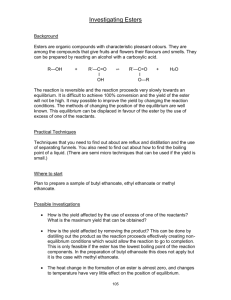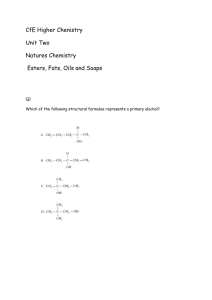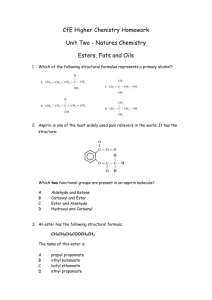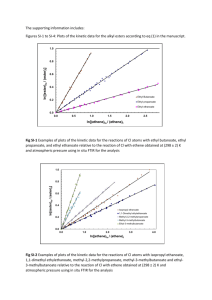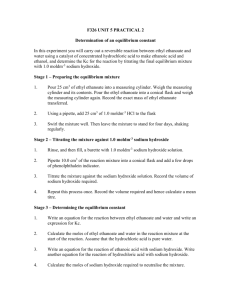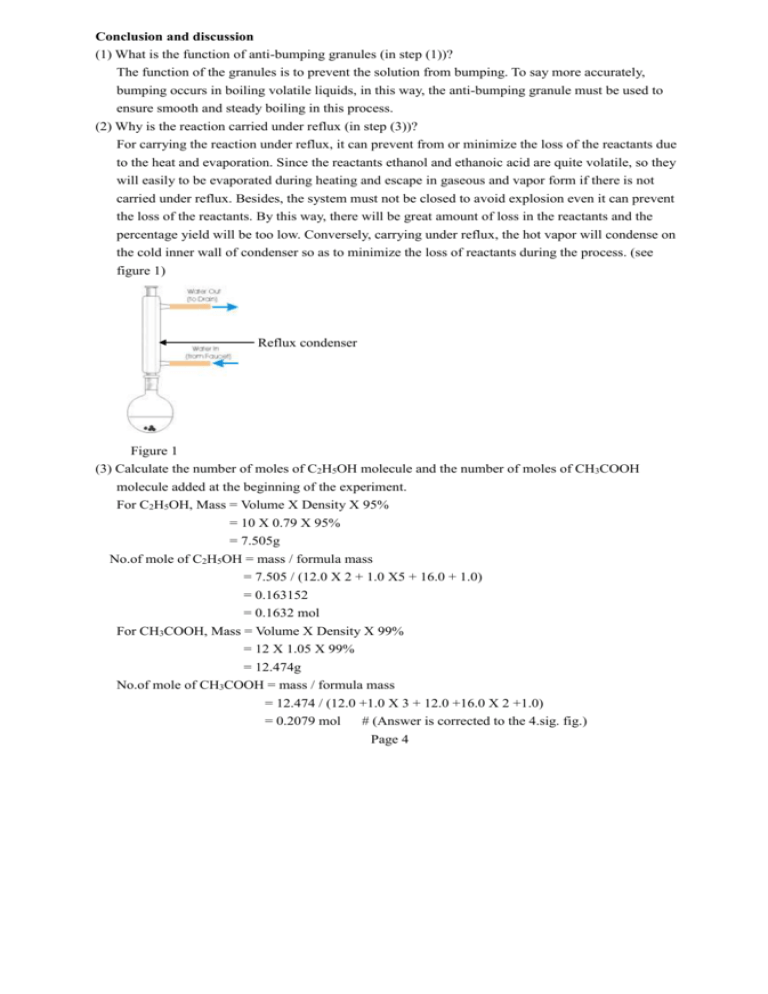
Conclusion and discussion
(1) What is the function of anti-bumping granules (in step (1))?
The function of the granules is to prevent the solution from bumping. To say more accurately,
bumping occurs in boiling volatile liquids, in this way, the anti-bumping granule must be used to
ensure smooth and steady boiling in this process.
(2) Why is the reaction carried under reflux (in step (3))?
For carrying the reaction under reflux, it can prevent from or minimize the loss of the reactants due
to the heat and evaporation. Since the reactants ethanol and ethanoic acid are quite volatile, so they
will easily to be evaporated during heating and escape in gaseous and vapor form if there is not
carried under reflux. Besides, the system must not be closed to avoid explosion even it can prevent
the loss of the reactants. By this way, there will be great amount of loss in the reactants and the
percentage yield will be too low. Conversely, carrying under reflux, the hot vapor will condense on
the cold inner wall of condenser so as to minimize the loss of reactants during the process. (see
figure 1)
Reflux condenser
Figure 1
(3) Calculate the number of moles of C2H5OH molecule and the number of moles of CH3COOH
molecule added at the beginning of the experiment.
For C2H5OH, Mass = Volume X Density X 95%
= 10 X 0.79 X 95%
= 7.505g
No.of mole of C2H5OH = mass / formula mass
= 7.505 / (12.0 X 2 + 1.0 X5 + 16.0 + 1.0)
= 0.163152
= 0.1632 mol
For CH3COOH, Mass = Volume X Density X 99%
= 12 X 1.05 X 99%
= 12.474g
No.of mole of CH3COOH = mass / formula mass
= 12.474 / (12.0 +1.0 X 3 + 12.0 +16.0 X 2 +1.0)
= 0.2079 mol
# (Answer is corrected to the 4.sig. fig.)
Page 4
(4) Assuming the reaction is irreversible, calculate, accordingly to the chemical equation, the
theoretical mass of ethyl ethanoate obtained.
As the reaction is “considered” as irreversible,
CH3COOH + C2H5OH CH3COOC2H5 + H2O
As the ethanol is limiting reagent, so no. of mole of ethanol = no. of mole of ethyl ethanoate
= 0.1632
Theoretical mass = no of mole of ethyl ethanoate X formula mass of ethyl ethanoate
= 0.1632 X (12.0 + 1.0 X 3 + 12.0 + 16.0 X 2 + 12.0 X 2 + 1.0 X 5)
= 0.1632 X 88
= 14.3616
= 14.36g
# (Answer is corrected to the 4.sig. fig.)
(5) Calculate the percentage yield of ester?
The actual mass obtained = Volume X Density
= 6.1 X 0.92
= 5.612g
Percentage yield = Actual mass obtained / Theoretical mass X 100%
= 5.612 / 14.36 X 100%
= 39.0808%
= 39.08%
# (Answer is corrected to the 4.sig. fig.)
(6) Suggest why the percentage is not 100%?
For the percentage yield is 39.08% which is less than and not 100%, by this, it can be concluded
that the reaction is non-stoichiometric. The low yield can be explained by the following ways:
The presence of reversible reaction-for the reaction between ethanol and ethanoic acid, it is
reversible and which is only considered to be irreversible for simplicity of calculations. For
reversible reaction like this, the ethanol and ethanoic acid will not be totally converted to ethyl
ethanoate but until the equilibrium point, so the percentage yield is low.
The presence of impure reaction-there may be some impurities in the reaction mixture, in this way,
the yield will be non-stoichiometric.
The volatility of product- As the product or ester is always volatile, which implies that the volume
and the mass of the product obtained would decrease by time, thus, the percentage yield is lower
than 100%. Besides
Page 5
(7) Suggest the methods to increase the percentage yield of ethyl ethanoate.
To increase the percentage yield of ethyl ethanoate can be achieved by removing water or ester
during esterification.
Esterification is reversible reaction. For all reversible reactions, they have equilibrium constant,
denoted by Kc. It should be the same if the reaction performed under same condition. In order to
keep the Kc constant, the reaction will shift right or left. In other words, if the concentration of
water or ester become low, the reaction will shift to right to produce more ester and water to keep Kc
constant. From this theory, the percentage yield of ethyl ethanoate can be increased by removing the
water (by dehydrating agents) or ester during the reaction. As removing water, the reaction will then
shift the right to produce more water, that means also produce more ethyl ethanoate. Increase in
production of ethyl ethanoate in turns increase the actual mass obtained. Since the theoretical mass
will not change, percentage yield of ethyl ethanoate will also increase.
Also, the simple distillation process should be repeated by few times:
After collecting the distillate boiling from 730C to 800C at the first time, stopper the test tube which
contains the distillate. And then let the mixture of pear-shaped flask cool down and then undergoes
the simple distillation again and so collect the distillate boiling from 730C to 800C again. Repeat this
time by time so as to maximize the amount of ester has been collected.
(8) Do you think the distillate obtained is pure ethyl ethanoate ? Suggest the methods to increase the
purity of ethyl ethanoate obtained.
It is estimated that the distillate obtained is not pure ethyl ethanoate though is distilled by simple
distillation.
To increase the purity, it can be done by fractionation* or fractional distillation (see figure2). In
fractional distillation, for much more efficient separation is obtained by the use of a fractionating
column. The way in which such a column operates is best illustrated by the type known as a “bubble
cap” column; it consists of a long tube divided into a number of separate compartments. The vapour
rising from the boiling mixture passes into the first compartment (or plate), and some will condense
there. The liquid(ester) lying on the first plate will therefore be richer in the component of lower
boiling point. The hot vapour will now bubble through this mixture, causing it to boil, and the
vapour passing into the second compartment will be still richer in the lower-boiling component. In
theory, each plate is equivalent to a separate distillation and should correspond with one step on the
boiling point diagram; in practice, however, the efficiency of the column is bound to be somewhat
less than that. If there is a sufficient number of plates in the column, the vapour that passes out of
the top of the column into the condenser will consist of the lower-boiling component in the pure
state. The liquid that runs back down the column (the reflux) is progressively richer in the
higher-boiling component, and the latter will eventually be left in the boiler almost in the pure state.
Also the purity of ester can be increased.
*fractionation requires for a long time, thus, not discussed here
Page 6
Figure 2
By Kong Siu Wai
Page 7
© All rights reserved.


